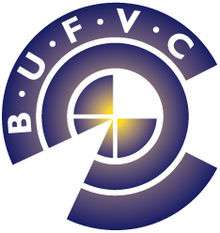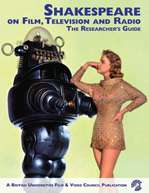British Universities Film & Video Council
The British Universities Film & Video Council (BUFVC) is a representative body promoting the production, study and use of moving image, sound and related media for learning and research. It is a company limited by guarantee, with charity status, serving schools, colleges and post compulsory education interests in the UK.

History
Founded in 1948 as the British Universities Film Council, the BUFC was established by a group of academic staff from various subject disciplines across the arts, humanities and sciences. In the 1960s the BUFC was allocated core funding from government as a grant-in-aid body of the British Film Institute (BFI). In 1982 the Council left the BFI with the remit to engage with UK higher education, changed its title to British Universities Film & Video Council and obtained recurrent core grant direct from the Department for Education and Science. In the early 1990s, with the re-organisation of UK higher education funding, the BUFVC's PES line was moved to the Higher Education Funding Council for England (HEFCE) and was paid over via The Open University. On 12 February 2007 the BUFVC became a 'related body' of HEFCE receiving core grant under Section 65 of the Further and Higher Education Act 1992 with oversight from the Jisc. It now has more than 200 subscribing member institutions in the UK.[1]
Governance
The BUFVC is governed by a board of fourteen trustees comprising at least ten elected names and up to four appointed names including one trustee appointed by HEFCE. At least one third of the trustees step down and/or are re-elected each year. Trustees are normally nominated and elected from the subscribing membership.
The BUFVC employs sixteen staff and operates in a mixed economy of earned income (from subscriptions, publications sales, events, courses and screenings), from core grant-in-aid support, and from research grants and sponsorship. It is an independent body with its own self-contained offices in central London.
BUFVC Services and Databases
The BUFVC offers a range of specialist services under the soubriquet Moving Image and Sound, Knowledge and Access and aims to know more about moving image and sound content, its meaning, context and scholarly value, than any other UK-based educational body. Some BUFVC services are delivered online worldwide without charge, whereas other services are only offered under authenticated access to users in the UK or to staff in BUFVC member institutions.
At the heart of the BUFVC is a specialist Information Service. This is the source of much of BUFVC's information which is published online and in print. Details of the BUFVC's print publications can be found via http://bufvc.ac.uk/publications/ and the BUFVC's quarterly magazine Viewfinder is described at http://bufvc.ac.uk/publications/viewfinder
The main online databases/online resources currently delivered by the BUFVC are:
TRILT–Television and Radio Index for Learning and Teaching which offers the best online information describing broadcast content received from over 500 channels of radio and television and delivered in the UK since 1923. The service currently carries some 25 million records and accumulates data at a rate of 1.3 million records per year. Data is delivered 10 days in advance of transmission and TRILT offers a customisable alert service for users. Users from UK licensed educational establishments which are BUFVC members, may also order copies of programmes on DVD or CD post-transmission. See http://bufvc.ac.uk/tvandradio/trilt (under authenticated access only). You may also try the Demonstration version, which is in open access.
The Researcher’s Guide to Screen Heritage is an online directory to UK archives and collections of artefacts relating to the history of moving image and sound. This resource is delivered in open access (see http://bufvc.ac.uk/archives)
Moving Image Gateway is a links database for websites delivering moving image and sound and related media content which might be of value for use in UK further and higher education. This resource is delivered in open access (see http://bufvc.ac.uk/gateway/)
The British Universities Newsreel Database (BUND) carries information on more than 180,000 cinema newsreel stories released into British cinemas between 1911 and 1979. This resource is delivered open access as part of the News On Screen section of the website (see http://bufvc.ac.uk/newsonscreen).
Three large-scale online resources, which are archive collections of Independent Local Radio recordings, are delivered to bona fide users in UK higher and further education in collaboration with Bournemouth University via http://bufvc.ac.uk/tvandradio/independent-radio
Newsfilm Online is a resource which was prepared for online delivery by the BUFVC in collaboration with ITN and Reuters Television. The resource, which amounts to some 65,000 movie items in two file formats for progressive download, is only available to staff and students of UK higher and further education institutions as part of the Jisc MediaHub (see http://jiscmediahub.ac.uk/)
Another significant collection of moving image and sound content which is delivered online and that was selected and prepared by the BUFVC is Film and Sound Online. This resource is delivered under authenticated access only to staff and students in sub-licensed universities and colleges in the UK (see http://www.filmandsound.ac.uk).
BUFVC Television and Radio Services
BUFVC Off-Air Recording Back-Up Service - the BUFVC records and retains, under licence and copyright exception, some 44,000 hours per year of UK television and radio content. Nearly two decades of these recordings are held from June 1998 onwards. The channels recorded are: BBC One, BBC Two, BBC Three (up to February 2016, when it moved online), BBC Four, ITV, Channel 4, More4 and Five. BBC Radio 4 and BBC Radio 4 Extra are also now recorded and retained. Copies may only be supplied to staff in subscribing member institutions which also hold an Educational Recording Agency (ERA) licence. See http://bufvc.ac.uk/tvandradio/offair
Box of Broadcasts (BoB) this is a shared online service for universities and colleges in the UK which also have current ERA licences. It offers staff and students the opportunity to record and retain streamed copies of programmes (and extracts from programmes) in their own personal online play-lists. It is a form of scholarly 'see it again/hear it again' service which retains programme copies as long as the users require them to be retained (unlike most broadcasters' equivalent online services which retain copies for a relatively short time only). As of March 2016 it contained over 1.4 million broadcasts. See http://bobnational.net/
TV Times Index (TVTip) provides a unique searchable index to the London edition of the TVTimes, the listings magazine for ITV broadcasts, from September 1955 to March 1985. TVTiP allows users to search for programmes, production staff and performers. It contains approximately 250,000 records.
This Week was a leading ITV current affairs series, running from January 1956 to December 1992. From 1978-1986 it was known as TVEye. The This Week database is a record of the entire production history of the series. It has been enhanced by the contributions of expert researchers and information shared with the project by FremantleMedia and used with their permission. This Week is accessed via the BUFVC Website and is authenticated by Athens jointly with the TV Times Project database (TVTiP). It is free at point of access to all staff and students in further and higher education institutions in the United Kingdom and to BUFVC members.
News on Screen
The BUFVC is responsible for the world’s leading resource for the study of newsreels and cinemagazines, at the heard of which is a central database holding over 180,000 records. Associated with these records are 80,000 downloadable documents offered as PDFs taken from original documentation (scripts, running orders, dope sheets and ephemera) from the original news production files. Additionally, the database can be used to access some 40,000 British Pathe newsreel items online. The BUND also carries information on content delivered as Cinemagazines - longer form single subject items included in British cinema programmes and some which were only shown to overseas audiences. This resource is delivered open access as part of the News On Screen section of the website (see http://bufvc.ac.uk/newsonscreen).
The BUFVC has also published several books related to this area including Yesterday's News: The British Cinema Newsreel Reader (2002, ISBN 0-901299-73-1) edited by Luke Mckernan; Filming History: The memoirs of John Turner, newsreel cameraman (2001, ISBN 0-901299-72-3) and Projecting Britain: The Guide to British Cinemagazines (2008, ISBN 978-0-901299-78-9) edited by Emily Crosby and Linda Kaye.

Shakespeare in Film, Television, Radio and Online
One of the BUFVC's main educational resources is its International Database of Shakespeare on Film, Television and Radio. This authoritative online database of Shakespeare-related content is continually growing and is international in scope. It holds over 8,000 records dating from the 1890s to the present day (see http://bufvc.ac.uk/shakespeare/). The BUFVC has also published two books on the subject: As You Like It: Audiovisual Shakespeare (ISBN 0901299634) edited by Cathy Grant (1992) and Shakespeare on Film, Television and Radio: The Researcher's Guide (ISBN 978 0901299796) edited by Olwen Terris, Eve-Marie Oesterlen and Luke McKernan (2009).
BUFVC Publishing and Distribution
The BUFVC publishes the quarterly journal Viewfinder, reference books such as The BUFVC Handbook and distributes documentaries and educational films on DVD.
BUFVC Events
Annually the BUFVC holds the Learning on Screen Awards (see http://bufvc.ac.uk/events/learningonscreen). The BUFVC also organises a range of one-day courses on need-to-know topics for university staff and researchers (see http://bufvc.ac.uk/courses)
References
- ↑ Luke McKernan, "Sixty Years of the BUFVC", Moving Image Knowledge and Access: The BUFVC Handbook, 4th edition, 2007